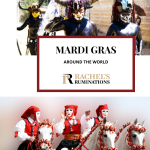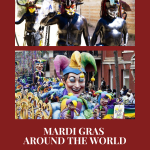Mardi Gras around the world – and Mardi Gras food!
Note: This is a collaborative post, which means it contains sections contributed by a number of other writers. Parts of it were first published in a different form on thewingedfork.com. I have rewritten it and added additional contributions.
Disclosure: This article contains affiliate links. If you click on one and make a purchase I will receive a small commission. This will not affect your price.
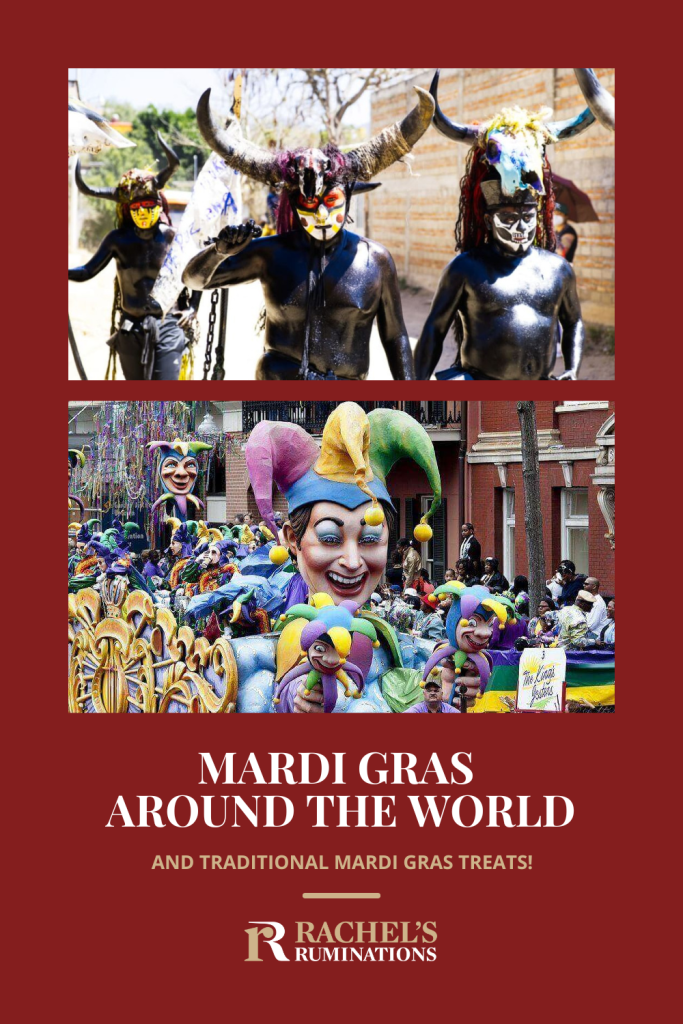
What is Mardi Gras? Or what is Fat Tuesday?
Mardi Gras is a celebration in the Christian calendar that precedes the Lenten fasting period, which in turn precedes Easter. Since the tradition was to fast for 40 days during Lent, communities would celebrate a feast before the fasting, which would also enable them to use up whatever rich foods they still had in the house. This would include foods made with fats like lard and butter and, since meat would be forbidden during Lent, they would enjoy meat dishes as well.
The dates for Mardi Gras vary depending on each place’s tradition. In some places it’s just a one-day celebration, while in others it can last all the way from the feast of Epiphany on January 6th until Shrove Tuesday, which is the day before Ash Wednesday.
Countries all over the world celebrate Mardi Gras – often also called Carnival or Carnaval – and each one celebrates it differently. Originally this was a Catholic celebration, so its deepest roots are in traditionally Catholic societies, especially Italy, home of the Pope. While its origins are in the Catholic Church, nowadays it’s a much more multi-cultural event, celebrated for the fun of it, not as a preparation for fasting. Most celebrations include a large dose of dancing, masquerades, parades, special food and lots of drinking. In many places the preparations start months beforehand.
To be honest, I’ve never been to a Mardi Gras celebration. This collaborative article is made up of contributions from many other travelers and bloggers, each describing how Carnival is celebrated in a particular place or the special Mardi Gras foods that are traditional there.
Mardi Gras in Europe
It’s not just in Italy, but that’s where we’ll start.
Sartiglia in Sardinia
One of the biggest Mardi Gras celebrations in Sardinia is called Sartiglia. This takes place on the last Sunday and Tuesday of Carnival in Oristano. It refers back to the medieval times of crusades, when equestrian and military tournaments became very popular.
Nowadays, the show has the only purpose of entertaining the public, while back in the day it was a propitiatory show for the harvest. Various skill shows take place during Sartiglia, but the most popular one is when masked knights (who can also be women, actually) on horses gallop towards a star and try to run it through with a spear. Needless to say, the show is thrilling.
Contributed by Claudia Tavani of Strictly Sardinia. Catch up with Claudia on Facebook at My Adventures Across The World.
The Venice Carnival and its masks
The Venice Carnival in Italy is one of the most famous and spectacular carnivals. It is known for marvelous carnival costumes and masks, excellent entertainment (outdoor and indoor performances, shows, and exhibitions), and music, all paired with first-class gastronomy.
Besides that, Venice Carnival is one of the oldest carnivals in the world. It traces back to the Middle Ages, the mighty Venice Republic, and its aristocrats who were so wealthy that plebs secretly mocked them. But several days before Lent, the authorities of the medieval Venice Republic allowed plebs to publicly mock the aristocracy. Masked and costumed, plebs mocked the privileged class publicly, and the rest is history.
It’s no wonder that stunning Venetian masks and costumes are famous as the most beautiful masquerade attire in the world. Venetian masks mostly have origins in Commedia dell’Arte characters like Plague Doctor, Pantalone, Zanni, Colombina, and Harlequin. For example, Pantalone personifies a witty but greedy Venetian merchant, Zanni represents a long-nosed stupid man, and Harlequin stands for an intelligent and prankish servant.
Venice Carnival takes place in February every year. It starts ten days before Lent and ends on Fat Tuesday (the day before Ash Wednesday). The main area of Venice Carnival performances is beautiful St Mark’s Square and lovely Riva Degli Schiavoni.
So if you want to see one of the most spectacular masquerade events in the world, head to Venice Carnival.
Contributed by Milijana of World Travel Connector.
If you can’t be in Venice at Carnival season, you can still hear all about the Venice Carnival (and about Casanova!) on this walking tour.
Cologne Carnival in Cologne
The Cologne Carnival is definitely one of the liveliest and most fun in Europe, and a must for all lovers of street parties. Unlike most other European carnivals that take place over just a few days, Carnival celebrations in Cologne are a week long, even though events officially start on November 11th, with the opening of Carnival season.
Then, Carnival week gets into full swing from the last Thursday before the beginning of Lent, and ends on Ash Wednesday. Thursday, the first day, is the Women’s Carnival, and the three main Carnival characters “officially” open celebrations at 11.11 am.
Then it’s a crescendo of events, parades, street parties and masked balls until the main Rose Monday parade, with over 70 floats, attended by hundreds of thousands of people.
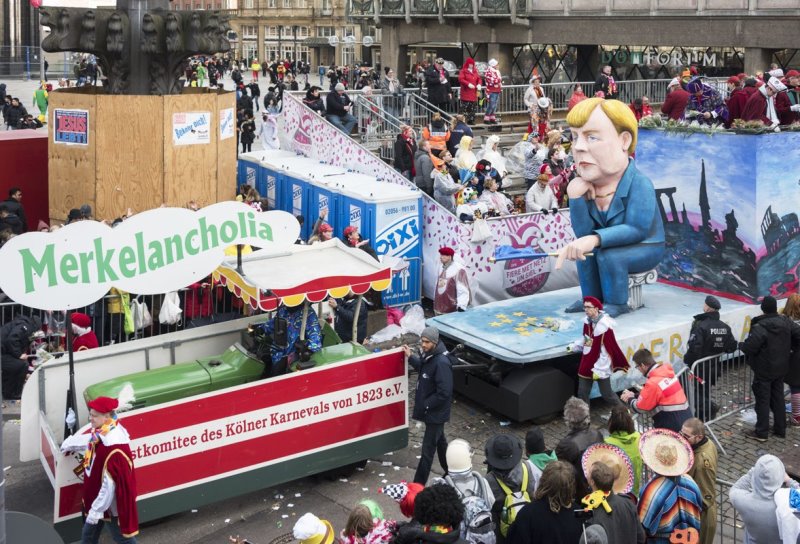
If it’s too hectic for you, go to the family parade on Sunday, which is a little more low key but no less fun! We highly recommend visiting Cologne Carnival at least once, remembering that it’s not just about the official events – the after parties are even more fun!
Contributed by Margherita Ragg from The Crowded Planet. Catch up with Margherita on Facebook at The Crowded Planet.
Many people don’t know that the Netherlands has its own version of carnival in the south of the country. This region is historically Catholic and, despite a checkered history (when the celebrations stopped), you can find some roaring parties in Limburg and Brabant each year. Each city has its own unique traditions, but expect polka-type music, everyone in costume, and some great costumes parodying political figures.
Carnival here is not so much about religion, but rather inverting social mores for a brief period. Every city erupts in parties that last for days after the Prince of Carnival receives the key. At this point, most cities have an alternative city name that refers to the city only during the Carnival period. It’s a lot of fun for tourists and locals.
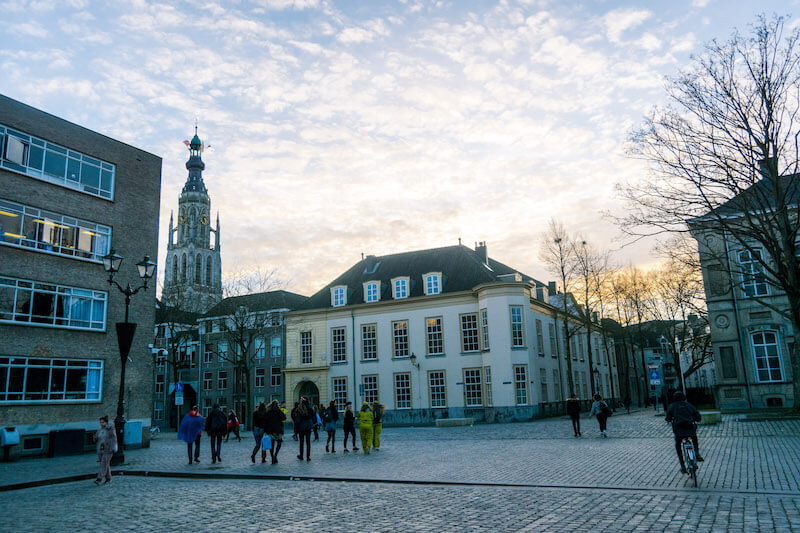
If you’re lucky enough to be in Amsterdam during this period, be sure to take a train down towards Brabant (Breda or Den Bosch), which are the closest big cities celebrating this fun holiday. Be sure to have a shot of Schrobbeler, a strong herbal liqueur from Tilburg that’s traditional for Carnival.
Contributed by Karen Wanderlustingk from Wanderlustingk. Catch up with Karen on Facebook at Wanderlustingk.
Fastnacht in Tyrol, Austria
The Tyrol region in Austria is known for its alpine Carnival traditions. These are also known as Fastnacht or Fasching in German, celebrating the few days before Carnival, while peak celebrations are held on Carnival day itself. Traditional processions are organized in various villages and cities across Tyrol, but only a handful hold these unique, colorful, and perhaps strange-looking, parades.
Locals celebrate the beginning of warmer days and end of the season, the triumph of spring over winter, by dressing up and wearing hand-carved wooden masks of funny-looking characters and shrovetide costumes. Various expressive characters exist such as the bear, the witch, the labere (singer), scheller (jingle ring holder), roller (jumps to create noise), kehrer (sweeper) and many more.
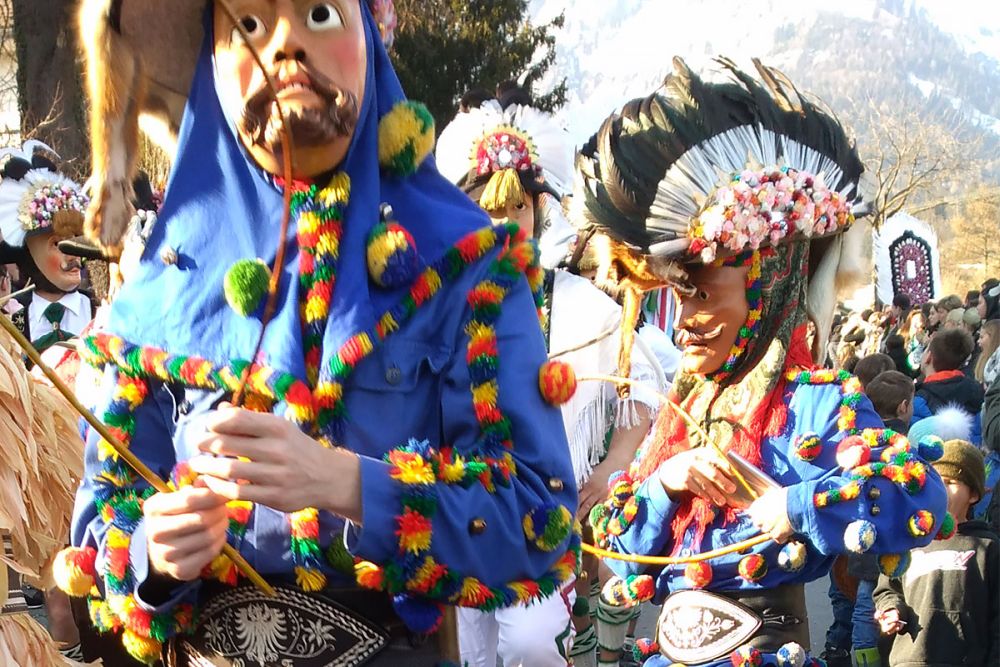
The most spectacular procession, called the Schemenlauf, is held in Imst. It’s been declared intangible cultural heritage by UNESCO. The Schemenlauf is organized only every four years. The Schellenlauf in Nassereith is also fascinating and takes places every three years. Other specific processions happen around Innsbruck, the capital of Tyrol, and in the western districts of Tyrol. Visitors to the region shouldn’t miss these centuries-old Carnival traditions when in Tyrol in February!
Contributed by Paul, who travels with his wife Helene to Europe and Asia. On Paulmarina you will find travel recommendations for couples, off the beaten path ideas, city guides and travel inspirations.
Carnival in Madeira, Portugal
Portugal is known for its festive Carnival celebrations in Torres Vedras and Lisbon, but the biggest Carnival celebration of all is on the island of Madeira. The week-long Madeira event has a different theme each year with multiple parades and elaborate costumes.
Carnival kicks off with the Festa dos Compadres in Santana – the town with the traditional triangular thatched-roof Madeira houses. This is followed by street entertainment in Funchal for an entire week prior to Shrove Tuesday.
Children make masks in school and then join the revelry in full costume in a parade down Avenida Arriaga on Friday. Nightlife during the week is filled with themed parties thrown by multiple establishments.
On Saturday night, thousands of people come together for a colorful and joyous float parade in Funchal with grandstands. Then on Mardi Gras there is the Trapalhão Parade. It’s a slapstick parade filled with political and social satire that is sure to be a fun time.
Other things to do during Carnival on Madeira include visiting the Madeira Botanical Garden, levada (water channel) walks and spending time on the beach – as Madeira has some of the best Portugal beach towns. So if you’re looking for one of the most notable Carnival celebrations, be sure to head to Madeira!
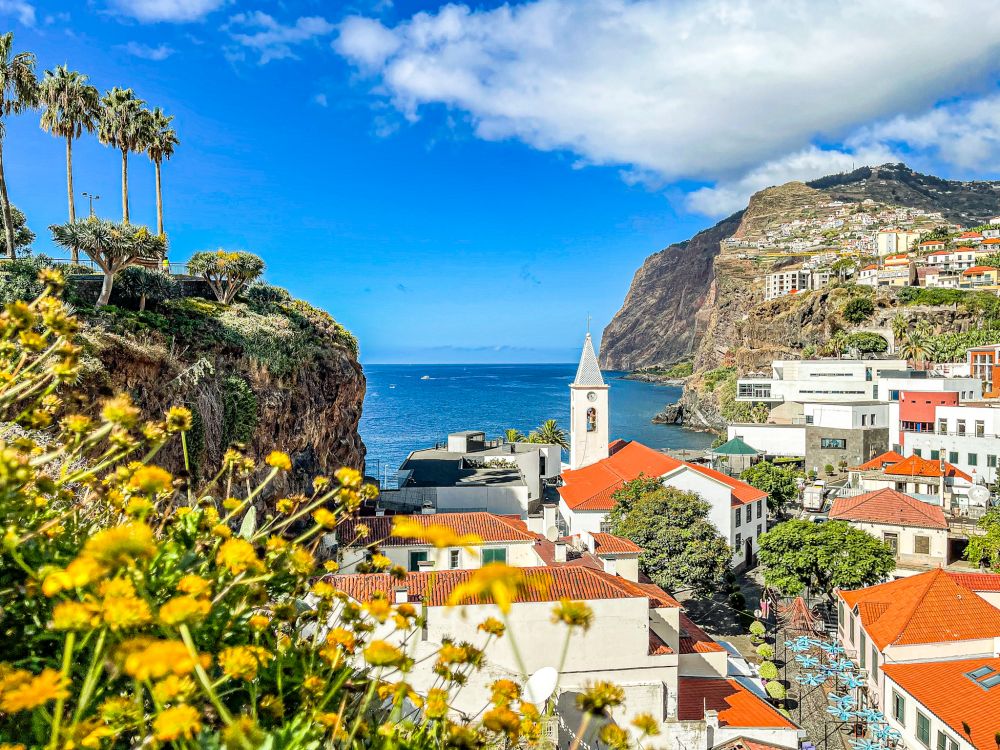
Contributed by Jenifer Byington, an empty nester who moved from Los Angeles to Ericeira, Portugal with her surfer husband, Guy. On their website, The Evolista, they share itineraries and tips for adventurous travel in North America, Europe and the Middle East.
US Mardi Gras celebrations
Of course, New Orleans is the most famous place to see Mardi Gras in the US, but don’t discount the celebrations in Mobile, and the unusual way it’s observed in Eunice will surprise you!
Famous Mardi Gras in New Orleans
Mardi Gras in New Orleans is the mother of all Mardi Gras celebrations in the U.S. Just like Christmas, Mardi Gras is a season, not just a single day, but Fat Tuesday (Mardi Gras means Fat Tuesday) is the biggest day of the celebration. This day can fall anywhere between early February and early March. The celebrations start on the feast of the Epiphany and get louder and more elaborate, culminating on the day before Ash Wednesday which is Fat Tuesday.
Everyone participates in the celebrations. There are dozens of parades all over the city. Marching Clubs and Krewes organize the parades, which can be extremely elaborate with their floats and costumed characters. Many of these participants plan and organize their parades for months ahead of time.
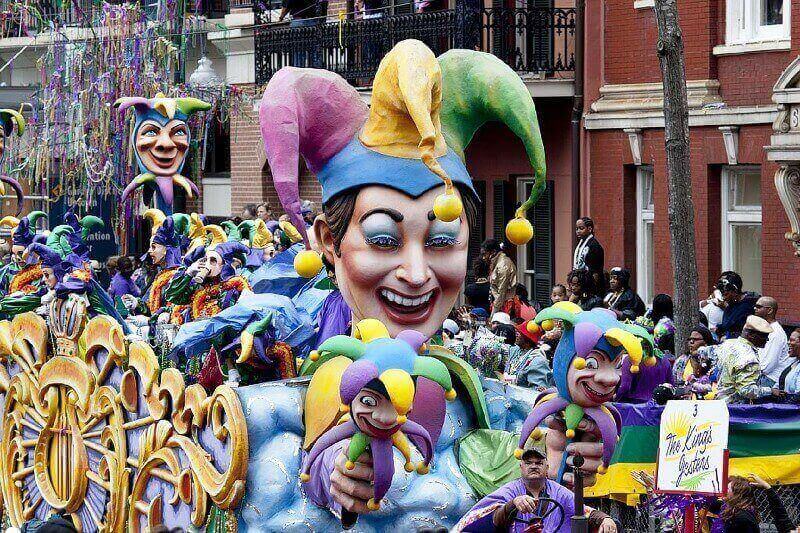
One of the traditions involves gathering as many beads as you can. These beads are sometimes thrown from the balconies and the parade floats as they glide by. The city does tend to get a bit wild with musicians playing in the streets and bars overflowing with revelers. But all good fun. The city is full at this time of year and it is difficult to get a hotel room if you have not reserved far in advance.
Mardi Gras in New Orleans is one of the world’s most fun celebrations.
Contributed by Talek Nantes from Travels with Talek. Catch up with Talek on Facebook at Travels with Talek.
If you can’t be in New Orleans for Mardi Gras, but you’re visiting in the months leading up to it, you might enjoy a visit to Mardi Gras World to learn how the floats are made and see some as they’re being built.
Mardi Gras with Moon Pies in Mobile, Alabama
When most people think of Mardi Gras, New Orleans comes to mind. However, the birthplace of Mardi Gras comes from about 140 miles to the east in Mobile, Alabama.
Mobile and New Orleans celebrate Mardi Gras in very similar ways. They both have Mardi Gras parades, throw beads, have Mardi Gras balls, and eat king cake. However, Mobile has a reputation for being the more family-friendly Mardi Gras celebration versus its neighbor in New Orleans.
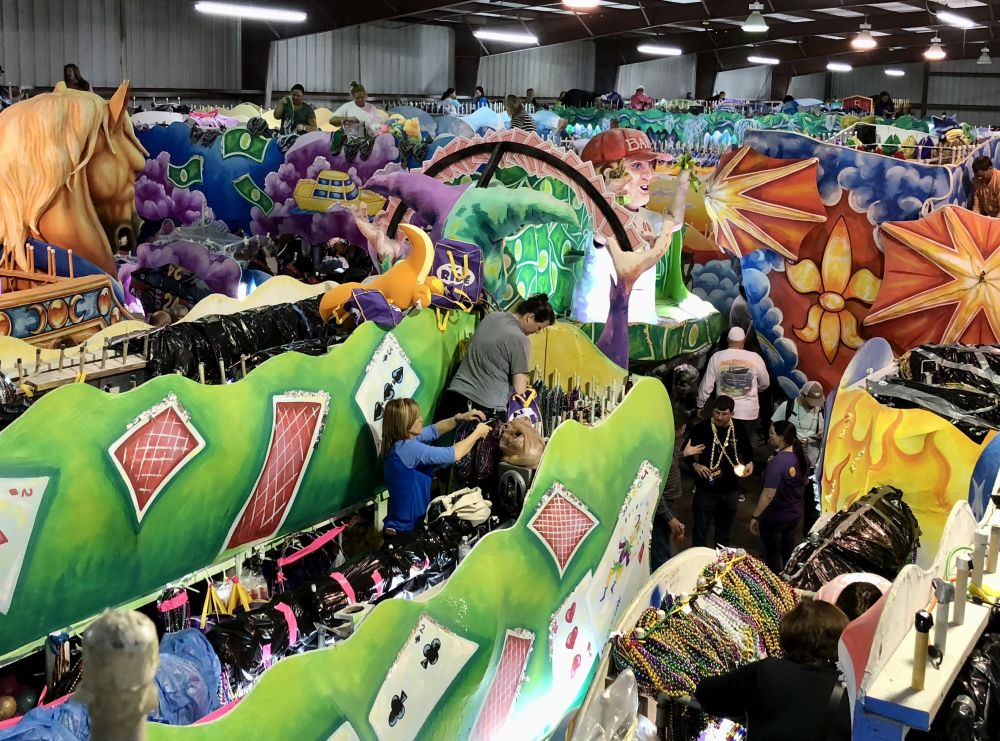
One way Mobile’s Mardi Gras is different is that this city has a tradition of throwing MoonPies. A MoonPie is a soft, sweet marshmallow and graham cracker sandwich covered either in chocolate, vanilla, banana, or orange. Because Mobile is famous for this Mardi Gras tradition, this city even has a MoonPie drop at midnight on New Year’s Eve.
Another tradition of Mobile Mardi Gras is Joe Cain Day. Joe Cain Day happens the Sunday before Fat Tuesday every year. This day is dedicated to celebrating the man who brought the carnival tradition back to Mobile.
The Joe Cain Day Procession is called the “people’s parade” and is open to anyone. It includes a procession of thousands of people including two special groups: the “Mistresses of Joe Cain” and the “Widows of Joe Cain.” They make a procession to Joe Cain’s gravesite and his original house.
Mardi Gras in Mobile is a 2.5-week-long celebration that everyone must experience.
Contributed by Kim Swanson: a wife, a mom of 3, and a lover of travel. She is the owner of the family travel blog Traveling Swansons. She loves traveling all over but especially loves big cities, National Parks and Disney.
Mardi Gras in Eunice, Louisiana, with chickens!
The Cajun country town of Eunice, LA has a family-friendly Mardi Gras tradition that is a world away from New Orlean’s high-profile flurry of floats, beads and hurricanes.
Each year the town hosts the Courir du Mardi Gras, the Fat Tuesday run. Participants don homemade tassled hobo costumes, beaky masks and tall hats called capuchons – they resemble Carnivale costumes you see in some parts of the Caribbean – and make their way through the streets on foot, horseback and in small wagons festooned in green, purple and gold ribbons. At a half dozen intervals the “courir” happens when they pause the parade to run after a chicken.
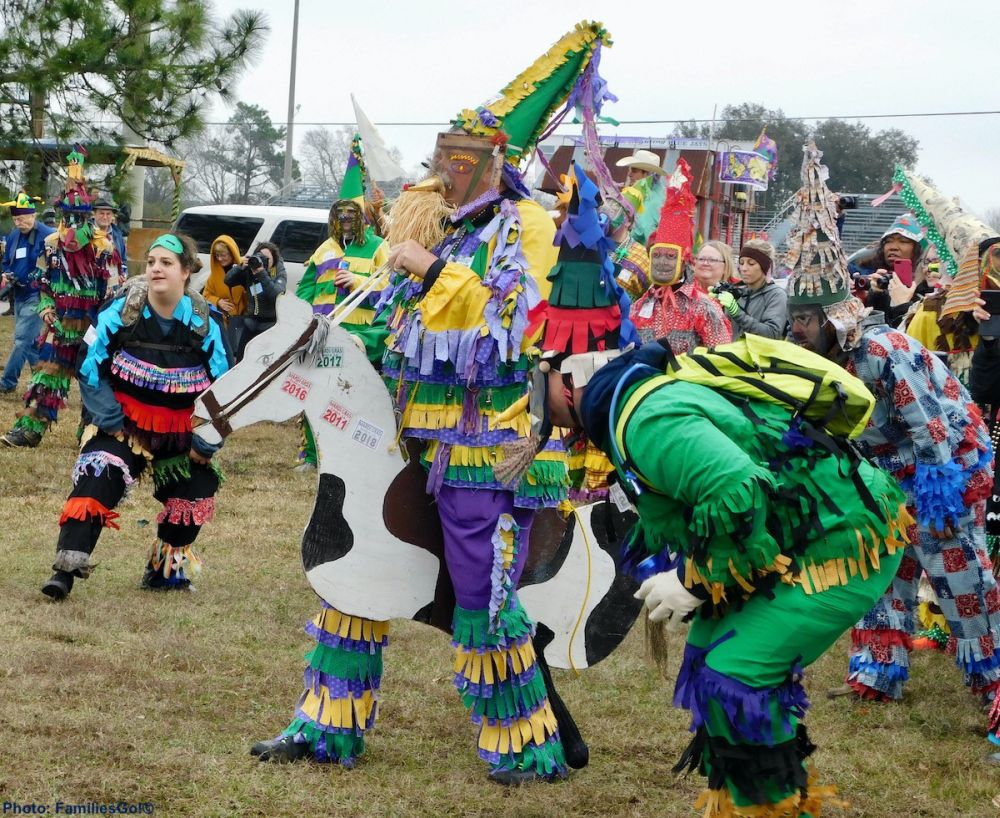
Historically they would catch the chickens as part of a quest for ingredients for a town gumbo. These days their quarries – who are not easy to catch by any means – just go back to their owners. The winners get bragging rights for the day. The parade has more people participating than watching and it has the feel of a community coming together out of tradition and for its own enjoyment; not for the tourists watching them. The day still ends with gumbo, but nowadays it’s usually been cooking at the community center since before the parade begins. All are welcome to have a bowl.
Contributed by Eileen Gunn at FamiliesGo!
Mardi Gras in Latin America
Rio de Janeiro’s Mardi Gras is probably the best known in Latin America, but it’s celebrated in other countries as well.
The biggest Mardi Gras: Rio de Janeiro, Brazil
Rio de Janeiro is one of the best places to celebrate Mardi Gras around the world, not only because it is the world’s biggest celebration, but because it is where you can hear the non-stop undeniable rhythm of samba.
Outside of the main parade, which takes place in a purpose-built stadium (known as the Sambadrome) in downtown Rio, there are street parties and festivals happening all over the city. It is said that more than 200 samba schools from around the country take part in the main parade. Also, each neighborhood in Rio has its own street carnival block which is basically a band consisting of percussion and wind instruments. The event is officially scheduled for five days in February (usually) but the celebrations start many weeks before.
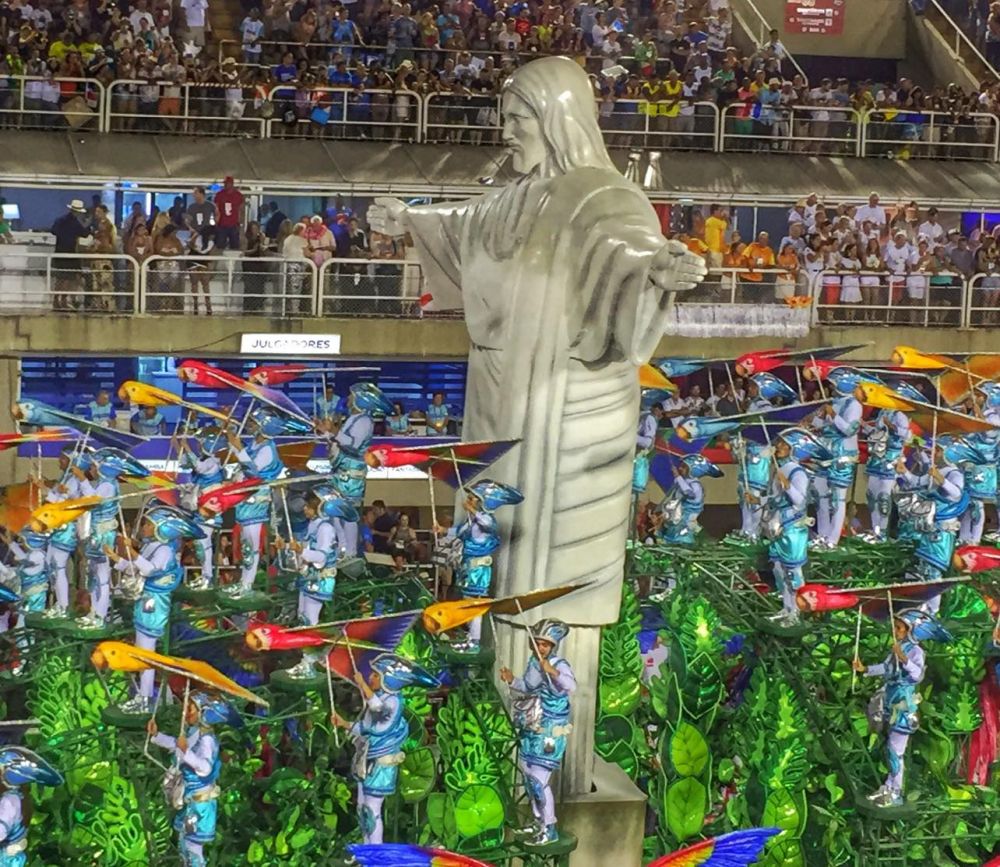
Since this carnival is one of the most artistic events the world has ever seen, it attracts tourists from everywhere, not to mention the domestic tourism that the city receives from all the other Brazilian states. Many cautious travelers who are concerned about safety in Rio de Janeiro and other Brazilian cities are often still drawn to this event and can pay anything from USD30 to USD300 to see parades at the Sambadrome.
One must-try food while in Rio for the carnival is feijoada, and if you get the chance, try one of the feathered costumes to fully appreciate the length that the Brazilians go to to put on one of the world’s most spectacular events.
Contributed by Daniel James from Layer Culture, a cultural traveler who dedicates his time to learning Spanish whilst exploring and learning about life in Latin America.
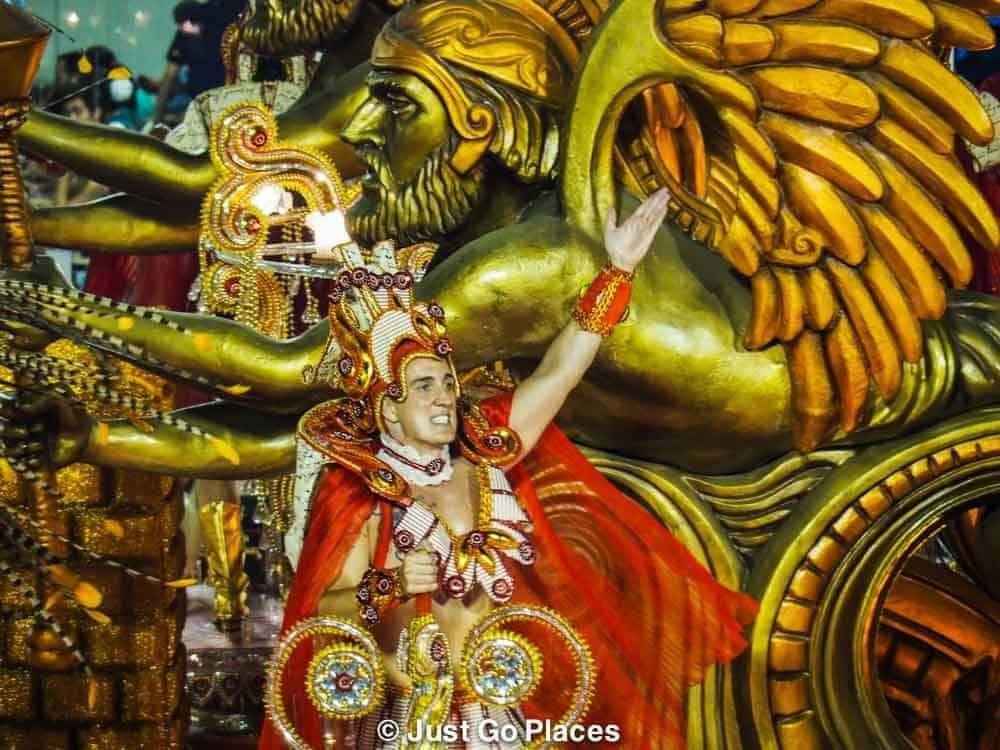
If you’re lucky enough to be in Rio for Mardi Gras, buy your tickets in advance for the parade at the Sambadrome!
If you prefer having your whole trip to Rio de Janeiro arranged for you, try one of these tours.
If you like Mardi Gras festivities, than you cannot miss the Carnaval de Barranquilla in Colombia. It is the second biggest Carnival in the world, second only to the legendary Rio Carnival in Brazil. It has been happening for over 100 years and UNESCO has proclaimed it one of the Masterpieces of the Oral and Intangible Heritage of Humanity. The Carnaval de Barranquilla is full of folklore, costumes, dances, music, parades.
The Carnival officially begins on the Saturday before Ash Wednesday and ends on Fat Tuesday. It’s a stunning spectacle. Visitors are amazed by the colors of intricate and impressive costumes ranging from traditional folklore to surreal creative creations. If you like partying and dancing then you are in for a treat. Barranquilla is where Colombian pop-star Shakira grew up, honing those world-famous dances and hip shakes! Several different music styles are played by orchestras and live bands and dances are performed in amazing choreographed shows.
There is an expression in Colombia that says, “Who lives the carnival, is who enjoys it.” The carnival is the biggest party of the year in Colombia and repeats every year for a reason. It is a chance for everyone to put aside their inhibitions, and eat, drink and be merry. Make sure you do not miss this once-in-a-lifetime experience.
Contributed by Alejandro Turbay from Please Live Your Dream. Catch up with Alejandro on Instagram at Please Live Your Dream.
A playful carnival in Ecuador
Celebrated across countless cities in Ecuador, Carnival in Ecuador is a special celebration totally unique to the country. While Carnival is celebrated in countries throughout South America, Ecuador’s fun, unique, and even playful traditions make traveling to Ecuador during Carnival a real joy.
One of the unique traditions of celebrating Carnival in Ecuador is “playing” Carnival. Children and adults alike purchase canisters of condensed foam, similar to shaving cream. They will spray it on unsuspecting victims, or willing participants, in streets, from buses, and wherever they can in the days leading up to Carnival. You’ll also find people throwing flour, water, and colorful powders in areas where many people are playing these carnival games. It’s messy but great fun!
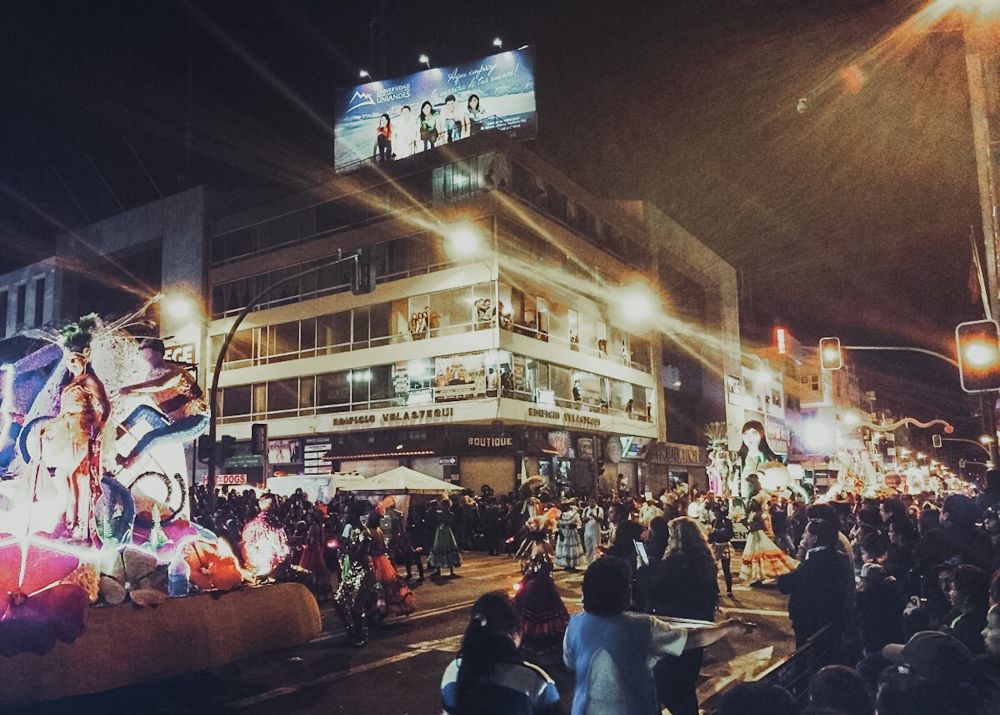
Some of the best places to celebrate Carnival in Ecuador include larger cities like Quito and Cuenca and even smaller cities and towns. Many residents of Quito head to the small town of Amaguaña, about an hour outside of the city, to celebrate with traditional carnival games, parades, and performances of traditional music, dance, and even theater.
The town of Ambato also holds one of the most impressive Carnival displays, with its famous Festival of the Flowers and Fruits coinciding with Carnival for an unforgettable experience. The highlight of days of celebrations is the Ronda Nocturnal, featuring an evening parade with countless floats, all covered in an impressive array of flowers, fruits, and even pastries. Visitors will also see a variety of marching bands, local music, dancing, and more as the parade twists through the city for hours.
Contributed by Carley Rojas Avila, an avid traveler and the creator behind Home to Havana. Having visited twenty-five countries and spent years living abroad, she shares destination guides and travel tips to help travelers and digital nomads feel at home when traveling off the beaten path to Havana or beyond.
In the state of Oaxaca, Mexican culture and traditions run deep. One of the best ways this is shown is through its festivals, and Carnaval is no different. In fact, Carnaval is one of my favorite festivals in Oaxaca. And you don’t need to travel outside of Oaxaca City to catch a glimpse at how different regions of the state celebrate.
On the Saturday before Lent, the city hosts a parade during which various communities from the state of Oaxaca showcase their unique Carnaval traditions.
Then, on the Tuesday before Lent, the celebrations continue in various small towns of Oaxaca, such as San Martin Tilcajete. Typically this pueblo draws visitors who want to learn about alebrijes, the mythical animal figures that are carved of copal wood and intricately painted with Zapotec designs in bright colors.

But for Carnaval, San Martin Tilcajete draws a crowd of revelers to parade with Los Aceitados or The Oiled Ones. With their bodies painted black with motor oil, cowbells hanging from their waist, and wearing masks made of natural materials, Los Aceitados dance and party throughout the town. It’s the last day to sin and they aren’t holding anything back. The band leads the way as beers and sips of mezcal are passed around to everyone – participants and tourists.
The celebration is a unique Carnaval experience that showcases the rich culture of Oaxaca, Mexico.
Contributed by Julien Casanova of Oaxaca Travel Tips. Julien was drawn to Oaxaca, Mexico by its vibrant culture, wonderful people, stunning beaches, and incredible food. After Oaxaca stole her heart, Julien decided to call Oaxaca home.
The food of Mardi Gras around the world
Given that the ways of celebrating Mardi Gras have evolved in so many different ways, it’s not surprising that each place has its own traditional food for the celebrations as well. We’ll start with the Italian ones. You’ll notice that they are all fried in fat, which undoubtedly stems from the tradition of eating fatty foods before the fast.
Chiacchiere
Carnival in Italy represents a tenacious tradition and culminates in the celebrations of Mardi and Jeudi Gras. During those two days, kids enjoy wearing costumes while adults focus on preparing traditional foods. A typical Mardi Gras food that unites all the different regional cuisines in Italy is chiacchiere.
This dish’s name literally means “chit-chat” in Italian. From town to town, it gets different names, like frappe, bugie, or cenci. Chiacchiere is a dessert and consists of extremely thin, crumbly fritters, cooked in sunflower oil. To preserve the chiacchiere’s friable texture, cooking oil needs to be below 350F/180C. Ancient Romans used to cook the chiacchiere in pork suet.

Before, during, and after Mardi Gras week, you’ll find chiacchiere everywhere in Italy, from bakeries to patisseries and restaurants, and of course, in the houses of the Italians. They are usually served with confectioner’s sugar, and in some areas they are combined with sanguinaccio, a cream made of chocolate and pork’s blood.
Pork is the other protagonist on Italians’ dining tables during the Mardi Gras celebrations. The Italian’s favorite way of cooking pork are: pan-fried sausage with broccoli, spareribs with beans, and ragus with minced pork with lasagna and other homemade pasta dishes.
Contributed by Annalisa from Travel Connect Experience. Catch up with Annalisa on Instagram at Travelconnectexperience.
Galani
Galani are traditional sweets of the Venice Carnival in Italy. Crispy galani are also known as Venetian crostoli. Galani strips have been the main delicacy of the joyful Venice Carnival for centuries.
Fried galani strips are a must-try traditional Italian food from Venice. These rectangular and thin pastry strips reminded Venetians of the ribbons the girls in Venice enjoyed wearing. Galani means ribbons in the Venetian dialect.
They are similar to angel wings. Essentially galani are deep-fried thin pastry strips, sprinkled with sugar. Authentic Venetian galani are made with flour, egg yolks, sugar, butter, vanilla, lemon peel, a pinch of salt, a few drops of local grappa, and a few drops of local sparking white Prosecco wine from the Veneto region.
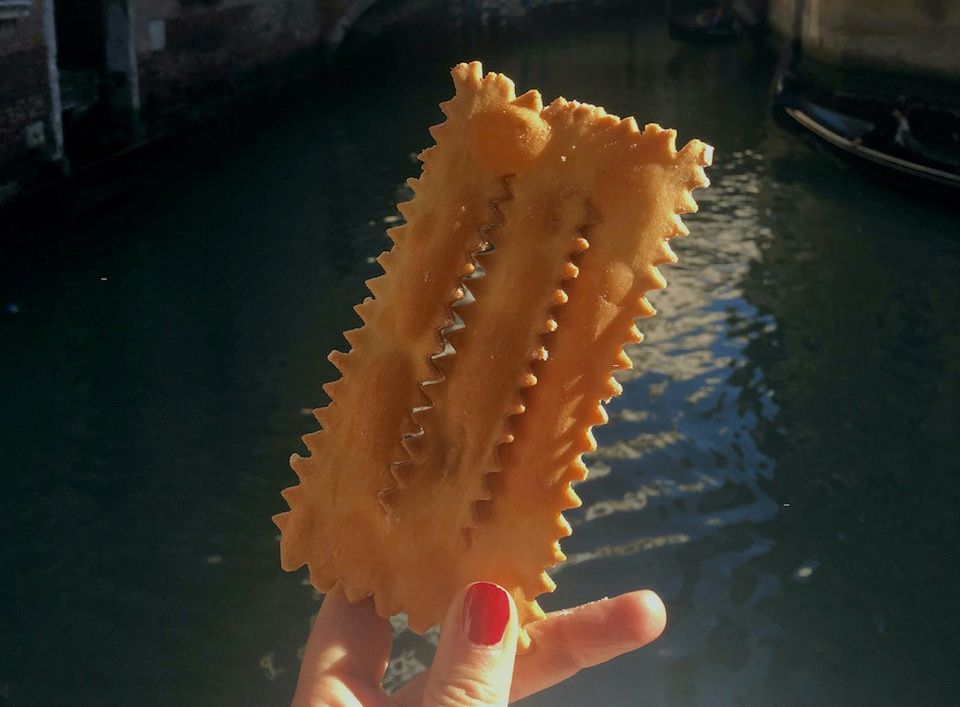
Authentic Venetian galani recipes always come with sweet Prosecco wine from the Veneto region. Galani pastry strips with a glass of sweet sparkling Prosecco are a must-have for a true celebration of Venice Carnival.
Crunchy galani are sold in bakeries and pastry shops and found at home in Venice during the Carnival season.
Contributed by Milijana of World Travel Connector.
Castagnole
Among the typical Italian desserts served on Mardi Gras and during Carnival are the castagnole. These treats are named after the chestnuts (in Italian castagne) with which they share a similar size and shape. Castagnole are sweet, fried balls, covered with sugar.
As Italian cuisine heavily relies on regional tradition, castagnole are typical of Liguria, Lombardia, Veneto, Emilia-Romagna, Lazio, and Marche. Over time the production of castagnole is typical also in the south, especially in Campania.
What all the regional varieties of castagnole have in common are some essential ingredients, along with the way of preparing and cooking them. These carnival desserts are made of eggs, sugar, wheat, and butter mixed and divided into small balls and then fried.
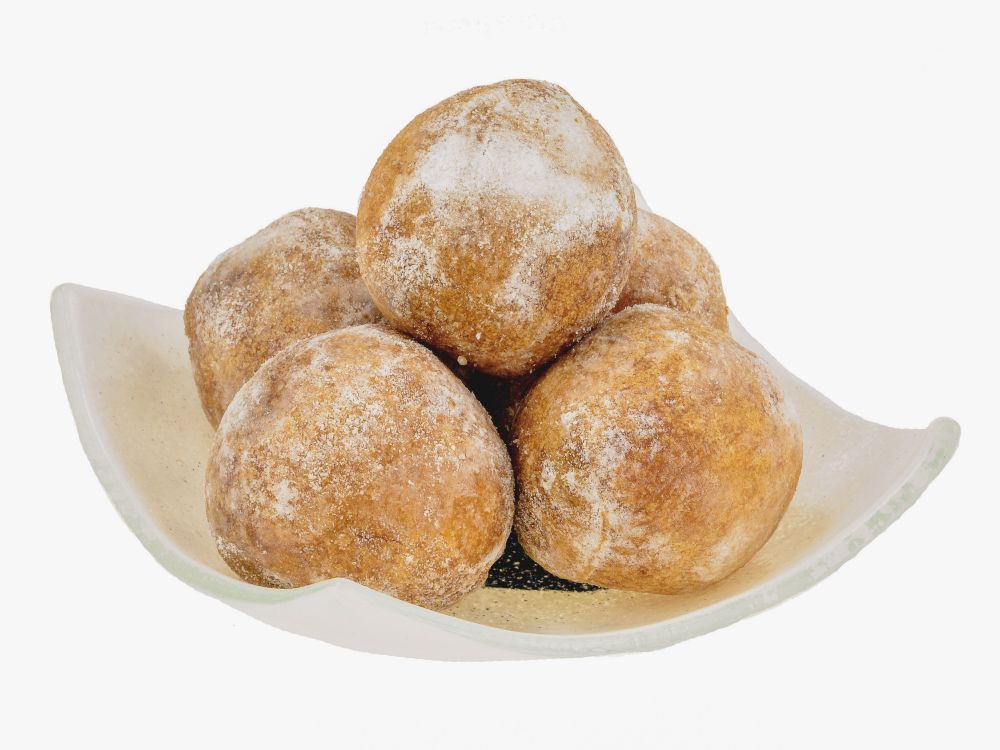
According to historians, their origin is relatively recent as the oldest recipes date back to the end of the 18th century. However, some studies believe that, with the different name of “Roman struffoli,” castagnole were already being made in the second half of the 17th century.
The original recipe is often proposed in different varieties. Instead of deep-frying, some prefer to bake castagnole in the oven; or instead of serving them plain, some fill them with whipping cream or custard. Another variety consists of covering them with honey instead of using sugar.
Contributed by Federica, who you can visit on Instagram or on Facebook.
Zeppole in Sardinia
Zeppole is a sort of fried doughnut sprinkled with sugar and best eaten as soon as it’s cooked. Eating zeppole is one of the best things to do in Sardinia during carnival and especially at Mardi Gras. Zeppole are usually sold by all bakeries during Carnival time, but lots of families still make them for home celebrations.
Contributed by Claudia from My Adventures Across The World. Catch up with Claudia on Facebook at My Adventures Across The World.
And here are some Mardi Gras treats from other parts of the world:
King Cake In New Orleans
One of our favorite Mardi Gras food traditions, King Cake is a delicious dessert that’s especially popular in New Orleans today. But its roots date back to France more than 300 years ago. We learned a lot about the history of the dish during a Cajun Food Tour in Lafayette, Louisiana.
It started out as part of the pre-Lenten celebrations in France and neighboring countries in Europe, and the original dish used dry French bread–type dough with sugar on top and a bean inside. Traditionally consumed during the festival of Epiphany at the end of the Christmas season, the King Cake was named after the biblical kings who made the journey to Bethlehem, with the bean said to represent the newborn Christ child.
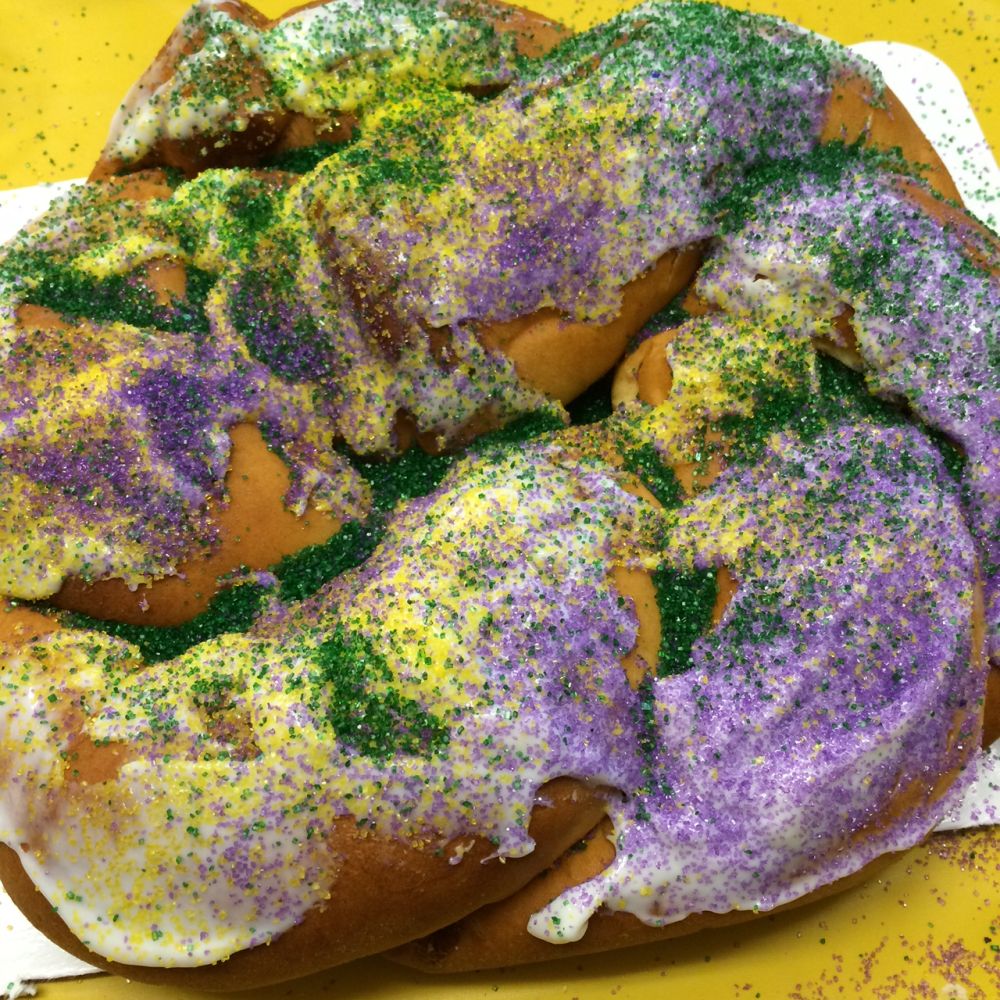
The King Cakes you’ll find in Louisiana around Mardi Gras today are much more elaborate and decadent. It’s typically a circle-shaped Danish – commonly topped with icing and/or sugar in the Mardi Gras colors of purple, gold, and green – with a delicious filling such as cinnamon, almond, apple, and/or chocolate in the middle.
There’s usually a plastic baby hidden within the cake as well. The person who finds it is said to be blessed with prosperity for the coming year, and is responsible for buying the next King Cake and throwing the next Mardi Gras party. These days, variations of the King Cake are common throughout North America and parts of Europe, where it is consumed regularly between the 12th day of Christmas and Mardi Gras/Carnival.
Description by Bret & Mary from Green Global Travel. Catch up with Bret & Mary on Facebook at Green Global Travel.
Laskiaispulla In Finland
Although Finland adopted Christianity relatively late, many Christian traditions are an integral part of Finnish culture today. One is the celebration of Shrove Tuesday, the day preceding the period of Lent. Like so many other traditions in Finland, however, this holiday also has pagan roots. Traditionally it was a day for the children to go sledding and the distance they sled was supposed to be indicative of the year’s harvest. Today, children do still go sledding, but they are also feasting on the famous laskiaispulla.
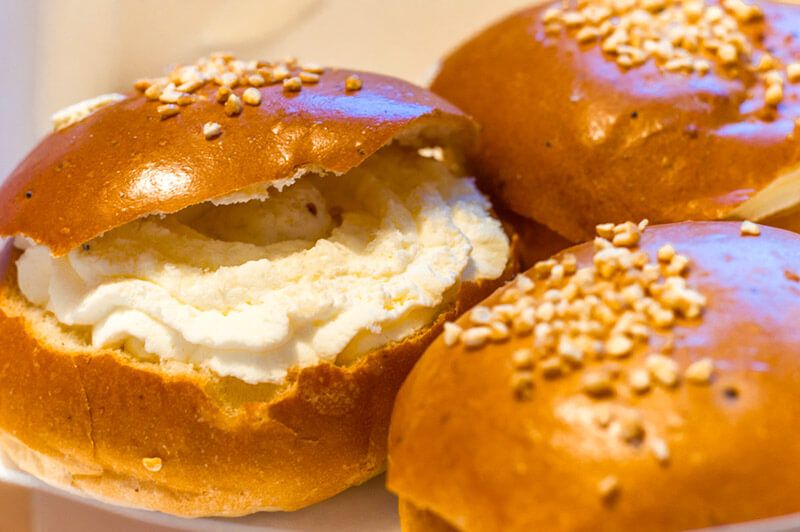
In short, a laskiaispulla is a sweet wheat bun spiced with cardamom. The top of the bun is generally cut off before it is filled with whipped cream and almond paste. The top is then put back on and serves as a lid. Today, you can find the traditional almond version, but also buns filled with jam instead. The most popular flavors are without a doubt strawberry and raspberry. Sweet treats similar to the Finnish laskiaispulla are also eaten in Sweden, Norway, Denmark, Iceland, and the Baltics.
Contributed by Jacky from Nomad Epicureans. Catch up with Jacky on Facebook at Nomad Epicureans.
Coconut-Filled Pancakes In India
In the East Indian culture, Mardi Gras and Shrove Tuesday are all about getting rid of the last of the rich food in the house by making pancakes: rich, sweet, coconut-filled pancakes that keep you reaching for more. They are reminiscent of French crepes, but are then filled with a delicious mixture of coconut, raisins, almonds, cashew nuts and more, and rolled into finger-sized bites of heaven. And just like every other East Indian sweet, the pancakes are super sweet and sometimes dripping in a sugary vanilla flavored syrup.
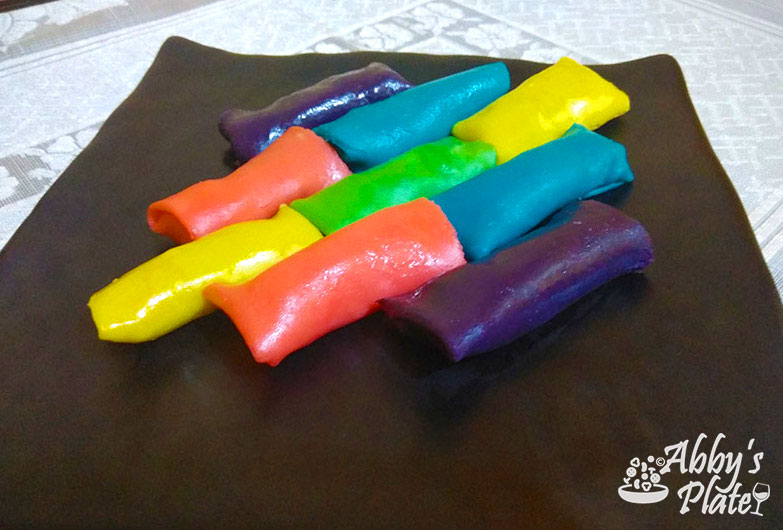
PS. I have to say it again because of all the misconceptions: people from the East of India aren’t called East Indians; rather they’re Bengalis, Hyderabadis and so on depending on the culture, city or state they originate from. East Indians are a cultural group from the West of India, particularly from the city of Bombay, India.
Anyways, you can’t buy these pancakes in stores. You have to order them from local East Indian ‘aunties’ who take orders, or you can make them at home yourself. Although each East Indian home has a slightly different recipe, the base ingredients are the same. If you want it, here’s my granny’s recipe for pancakes.
By Abby of Abby’s Plate.
Other useful Mardi Gras FAQS and trivia
Why is Mardi Gras called Mardi Gras?
The term is French for “Fat Tuesday.” France is a predominantly Catholic country and celebrated Mardi Gras early on. This is why most of the long-standing Mardi Gras celebrations in the US are in places with a history of colonization by the French, like Louisiana and Alabama. In New Orleans, the festival is called Carnaval, and Mardi Gras is the last day of the festival.
What Are Mardi Gras Krewes?
Mardi Gras Krewes are social groups, particularly in the US, who put together the Mardi Gras parades, creating the elaborate floats and the equally elaborate dancers’ costumes. The earliest Krewe formed in the 18th century, and more came together in the 19th century.
What are the Mardi Gras colors?
Fat Tuesday colors are purple, green and gold.
What do the Mardi Gras colors mean? How did these colors get associated with Mardi Gras?
In 1872, Grand Duke Alexei Alexandrovich of Russia visited New Orleans, where he was the guest of honor at the first Mardi Gras parade run by the Krewe Rex. They chose the colors purple, green and gold. Purple represented justice, green represented faith, and gold, not surprisingly, was power. Those colors just stuck and have been traditional ever since.
When was the first Mardi Gras in the US?
It’s not really clear when Mardi Gras was first celebrated in the US. Pierre Le Moyne d’Iberville and Jean Baptiste Le Moyne de Bienville, (who founded New Orleans not long after and became its first governor under French rule) were French explorers who landed near New Orleans in 1699. It happened to be Mardi Gras, so they celebrated it modestly at the place where they landed. Mardi Gras has been celebrated in New Orleans and other places in the US ever since.
However, the people of Mobile, Alabama, have a different story. They believe that Sieur de Bienville traveled further and established Mobile first, celebrating Mardi Gras there in 1703 for the first time. The first krewe, they believe, formed in Mobile, not New Orleans, in 1711, though the word “krewe” wasn’t coined until more than a hundred years later.
When is the next Mardi Gras?
Here are the Mardi Gras dates for the next few years:
2023: February 21
2024: February 13
2025: March 4
2026: February 17
2027: February 9
2028: February 29
2029: February 13
2030: March 5
What is the order of the Lenten season?
The Lenten season always follows a certain order:
- Shrove Tuesday a.k.a. Mardi Gras a.k.a. Fat Tuesday
- Ash Wednesday: The day after Shrove Tuesday, and the first day of Lent.
- Lent: 40 days, not including Sundays. The fasting period marks the 40 days Jesus spent in the wilderness.
- Palm Sunday: The Sunday before Easter Sunday and the beginning of Holy Week, which lasts until Easter. Commemorates Jesus’s arrival in Jerusalem.
- Maundy Thursday: Commemorates the Last Supper.
- Good Friday: Commemorates the Crucifixion.
- Easter Sunday: Commemorates Jesus’s resurrection. This is also the last day of Lent.
Is Mardi Gras celebrated where you live? How similar is your celebration to any of these? And are there particular foods associated with it where you live? Comment below to share your traditions!
My travel recommendations
Planning travel
- Skyscanner is where I always start my flight searches.
- Booking.com is the company I use most for finding accommodations. If you prefer, Expedia offers more or less the same.
- Discover Cars offers an easy way to compare prices from all of the major car-rental companies in one place.
- Use Viator or GetYourGuide to find walking tours, day tours, airport pickups, city cards, tickets and whatever else you need at your destination.
- Bookmundi is great when you’re looking for a longer tour of a few days to a few weeks, private or with a group, pretty much anywhere in the world. Lots of different tour companies list their tours here, so you can comparison shop.
- GetTransfer is the place to book your airport-to-hotel transfers (and vice-versa). It’s so reassuring to have this all set up and paid for ahead of time, rather than having to make decisions after a long, tiring flight!
- Buy a GoCity Pass when you’re planning to do a lot of sightseeing on a city trip. It can save you a lot on admissions to museums and other attractions in big cities like New York and Amsterdam.
- Ferryhopper is a convenient way to book ferries ahead of time. They cover ferry bookings in 33 different countries at last count.
- It’s really awkward to have to rely on WIFI when you travel overseas. I’ve tried several e-sim cards, and GigSky’s e-sim was the one that was easiest to activate and use. You buy it through their app and activate it when you need it. Use the code RACHEL10 to get a 10% discount!
- Another option I just recently tried for the first time is a portable wifi modem by WifiCandy. It supports up to 8 devices and you just carry it along in your pocket or bag! If you’re traveling with a family or group, it might end up cheaper to use than an e-sim. Use the code RACHELSRUMINATIONS for a 10% discount.
- I’m a fan of SCOTTeVEST’s jackets and vests because when I wear one, I don’t have to carry a handbag. I feel like all my stuff is safer when I travel because it’s in inside pockets close to my body.
- I use ExpressVPN on my phone and laptop when I travel. It keeps me safe from hackers when I use public or hotel wifi.


